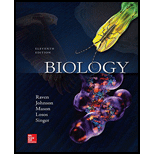
Concept explainers
Which cells lack living protoplasts at maturity?
a. Parenchyma
b. Companion
c. Collenchyma
d. Sclerenchyma
Introduction:
Plant tissue is defined as a group of cells that carry out a specific function. It is a functional unit of the plant that connects all the organs (stems, leaves, and roots) of the plant with one another. The three basic types of the plant tissues are ground tissue that includes parenchyma, collenchyma, and sclerenchyma cells, vascular tissue that includes tracheids, vessel elements, sieve tubes, and companion cells, and dermal tissue that includes epidermal cells, trichomes and stomata.
Answer to Problem 1U
Correct answer:
Sclerenchyma cells are the thick-walled cells that lack the living protoplast at maturity. Therefore, option d. is correct.
Explanation of Solution
Reason for the correct statement:
The sclerenchyma cells are tough cells with rigid cell walls. They lack the living protoplast at maturity. They are rigid and non-living cells that provide strength to the plant.
Option d. is given as “Sclerenchyma”.
As “the sclerenchyma does not have a living protoplast at the time of maturity,” it is the right answer.
Hence, option d. is correct.
Reasons for the incorrect statements:
Option a. is given as “Parenchyma”.
Parenchyma tissues contain a living protoplast at maturity. Therefore, it is a wrong answer.
Option b. is given as “Companion”.
The protoplast is present in the companion cells at the time of maturity. Therefore, it is a wrong answer.
Option c. is given as “Collenchyma”.
Collenchyma tissues also have live protoplast at maturity. Therefore, it is a wrong answer.
Hence, options a, b, and c. are incorrect.
Conclusion:
The plant cells that lack living protoplasts (all the components of the plant cell excluding the cell wall) at maturity are sclerenchyma.
Want to see more full solutions like this?
Chapter 36 Solutions
Biology
- What is behavioral adaptarrow_forward22. Which of the following mutant proteins is expected to have a dominant negative effect when over- expressed in normal cells? a. mutant PI3-kinase that lacks the SH2 domain but retains the kinase function b. mutant Grb2 protein that cannot bind to RTK c. mutant RTK that lacks the extracellular domain d. mutant PDK that has the PH domain but lost the kinase function e. all of the abovearrow_forwardWhat is the label ?arrow_forward
- Can you described the image? Can you explain the question as well their answer and how to get to an answer to an problem like this?arrow_forwardglg 112 mid unit assignment Identifying melting processesarrow_forwardGive only the mode of inheritance consistent with all three pedigrees and only two reasons that support this, nothing more, (it shouldn't take too long)arrow_forward
- Oarrow_forwardDescribe the principle of homeostasis.arrow_forwardExplain how the hormones of the glands listed below travel around the body to target organs and tissues : Pituitary gland Hypothalamus Thyroid Parathyroid Adrenal Pineal Pancreas(islets of langerhans) Gonads (testes and ovaries) Placentaarrow_forward
 Biology (MindTap Course List)BiologyISBN:9781337392938Author:Eldra Solomon, Charles Martin, Diana W. Martin, Linda R. BergPublisher:Cengage Learning
Biology (MindTap Course List)BiologyISBN:9781337392938Author:Eldra Solomon, Charles Martin, Diana W. Martin, Linda R. BergPublisher:Cengage Learning Biology: The Dynamic Science (MindTap Course List)BiologyISBN:9781305389892Author:Peter J. Russell, Paul E. Hertz, Beverly McMillanPublisher:Cengage Learning
Biology: The Dynamic Science (MindTap Course List)BiologyISBN:9781305389892Author:Peter J. Russell, Paul E. Hertz, Beverly McMillanPublisher:Cengage Learning
 Concepts of BiologyBiologyISBN:9781938168116Author:Samantha Fowler, Rebecca Roush, James WisePublisher:OpenStax College
Concepts of BiologyBiologyISBN:9781938168116Author:Samantha Fowler, Rebecca Roush, James WisePublisher:OpenStax College Biology Today and Tomorrow without Physiology (Mi...BiologyISBN:9781305117396Author:Cecie Starr, Christine Evers, Lisa StarrPublisher:Cengage Learning
Biology Today and Tomorrow without Physiology (Mi...BiologyISBN:9781305117396Author:Cecie Starr, Christine Evers, Lisa StarrPublisher:Cengage Learning Biology: The Unity and Diversity of Life (MindTap...BiologyISBN:9781305073951Author:Cecie Starr, Ralph Taggart, Christine Evers, Lisa StarrPublisher:Cengage Learning
Biology: The Unity and Diversity of Life (MindTap...BiologyISBN:9781305073951Author:Cecie Starr, Ralph Taggart, Christine Evers, Lisa StarrPublisher:Cengage Learning





